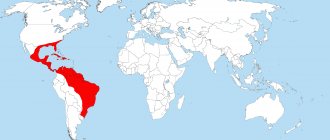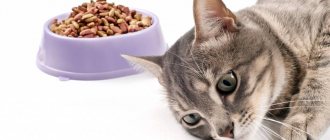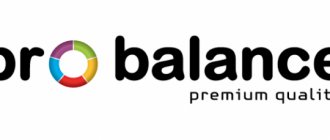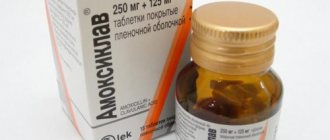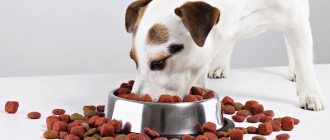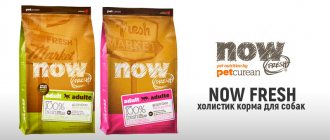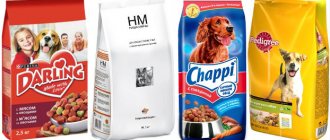Ready-made dry food is a concentrated food, so even a small portion contains a fairly large amount of calories, so an error in dosage of even 10–20 grams can be quite noticeable. If an animal is chronically malnourished, it becomes weakened and vulnerable to disease. Overeating also does not bode well and leads to obesity and metabolic disorders. Therefore, it is so important to correctly determine the dosage of dry food for your dog.
Start by reading the information on the product packaging. Manufacturers usually place a table on the back of the package that allows you to determine the daily intake in accordance with the pet’s current weight. When drawing up recommendations, the developers of the Akana and Orijen diets also took into account such an important factor as physical activity.
An example of calculating a diet for a small breed dog
Let's take the Acana Grassland Dog complete food as an example and look at the table of feeding norms. As you can see, the dosages of dry food for miniature breed dogs are very small.
For example, a Pomeranian Spitz with a body weight of about 2 kg will need only 40 grams of food with high physical activity, and about 30 g with low physical activity. Please note that the dosages in the table are daily, not one-time. Healthy dogs older than one year are usually fed a couple of times a day. This means that our Spitz only needs 15–20 grams of dry food at one time.
Individual needs
When determining the amount of dry food for a dog, you should understand that the food manufacturer indicates average values in the tables, which do not take into account the characteristics of your pet specifically. For example, the nutritional needs of dogs that engage in various types of canine sports or hunting vary greatly between competition and off-season periods. Also, dogs living in apartments need less food than animals kept outside, where a lot of energy is spent on heating the body. Therefore, do not be afraid to adjust the daily amount of dry food taking into account the characteristics of your pet, the main thing is that the dog does not gain excess weight.
Food dosage for puppies and young dogs
All of the above applies to adult dogs, but puppies have completely different needs and “standards”. Young organisms continuously grow and develop, which means they need more energy and “building materials” than already formed ones. The daily dosage of food for a puppy under 3 months of age should be 2 times higher than the corresponding norm for an adult of the same size. This amount of food is divided into 4–6 feedings.
At 3-6 months, the dosage calculated by weight is increased by 50%, at 6-11 months - by 25%. From 12 months, a young dog can be fed according to the recommendations in the main part of the table.
How many times a day should you feed your dog?
The number of feedings depends on the age of the animal, as well as the total volume of feed. The norm is calculated individually for each dog; there are only general recommendations that you can follow, but no one except the owner can say exactly how much food a dog needs. An animal should not decide for itself when and how much food to consume. Free feeding is unacceptable, because it threatens obesity and pickiness.
It is better to feed according to a schedule, for example, give 2/3 of the daily requirement in the morning, and the rest in the evening. By the way, dogs tend to sleep after eating and, knowing this feature, you can use it. If the pet is left at home alone while the owner is at work, then having eaten a large portion in the morning, the animal will probably devote most of the day to sleep.
Number of feedings depending on the age of the dog
| Up to 3-4 weeks | Puppies are not separated from their mother, they feed on breast milk as much as they want. |
| From 3-4 weeks | Puppies begin to be accustomed to solid food, fed 5 times a day every 3-4 hours, and large breed puppies are fed 4 times a day. |
| From 2 months | 3-4 times a day |
| From 3 to 6 months | 3 times a day |
| From 6 months | 2 times a day |
| From 12 months* | 1-2 times a day |
*Adult dogs need to be fed 1-2 times a day. For example, a large breed dog requires up to 1 kilogram of food per day, but it is advisable to divide this amount into two parts and feed the pet twice a day. A medium-sized dog can be fed once a day.
If a meal was missed for any reason, then you cannot increase the next portion. The pet will not die of hunger, but it can easily overeat.
What to do if your pet eats more or less than normal?
If the dog does not eat the proposed amount, and still looks well-fed and healthy, the owner has nothing to worry about. The feed dosages indicated on product packages are indicative and cannot take into account all the individual characteristics of a particular animal. Calorie needs often decrease in older dogs (over seven years of age) with less walking and exercise.
If the pet is clearly not eating enough, you can increase the norm, but with caution. Still, the animal is not able to independently determine how much it needs. Dogs evolved under rather harsh conditions: there was not enough food, and access to it was irregular. After domestication, they have largely retained their “wild” habits and instinctively strive to absorb all the food that is currently available. If there is always an excess of food, gaining extra pounds is inevitable, which will eventually lead to disruptions in the body’s functioning.
Benefits of dry food
Many owners see the time-saving and convenience benefits of dry food. Of course, if the dog does not need to prepare food separately, just pour the granules into a bowl, this significantly saves time and effort. However, the benefits of dry food do not end with these two aspects.
Undoubtedly, natural food is considered a more natural and healthy choice for feeding your pet. However, if you have difficulties with the preparation, balance and usefulness of a natural diet, then it is better to switch your pet to high-quality industrial food.
Dry food is usually divided into classes, we will talk about this below. It is important to know that food of super premium class and higher is fully fortified, that is, it saves you from the need to give your dog regular vitamin courses.
Each pack of food contains detailed composition and recommendations for compiling the daily intake. This information is not a call to action, but it provides basic information and allows you to correctly create a diet, even if you have no experience in keeping dogs.
Dry food not only serves as a source of nutrition, but also allows the dog to clean off plaque naturally. However, moderation is important in everything. Feeding exclusively dry food leads to rapid wear of the enamel, which can lead to serious dental problems.
According to the recommendations of veterinarians and food manufacturers, the diet of an adult dog should consist of 75% dry and 25% wet food.
When does a dog need extra nutrition?
There are situations when your pet is not only allowed, but even recommended to feed food in excess of the amount specified by the manufacturer:
- during gestation and feeding of puppies. For pregnant dogs, 25–50% is added to the usual dosage of dry food, and for nursing dogs, there is no dietary restriction at all. During this crucial period, underfeeding is much more dangerous than overeating;
- in winter cold when kept outdoors or in an unheated room. In this case, it is advisable to increase the norm by 10–20% of the recommended;
- with underweight. If the problem is due to poor living conditions (for example, the dog has gone through a period of malnutrition), it is permissible to temporarily increase the dosage of dry food. If your pet begins to rapidly lose weight despite normal feeding, it is reasonable to contact a veterinarian to rule out diseases and only then adjust the norm.
Frequency of feeding your dog dry food
When calculating the frequency of feeding a dog with dry food, it is important to take into account that granules, not soaked, are introduced into the menu no earlier than the complete change of teeth. Typically, a puppy's teeth will completely change by 6-7 months of age. In outbred and rapidly maturing dogs, a complete change of teeth can occur by 5–6 months.
You can calculate the frequency of feeding your dog based on the recommendations given on the food pack or use the standard chart:
- Age 4–6 months: 3–4 meals.
- Ages 6–12 months: 3 meals.
- Ages over 1 year: 2 meals.
When calculating the frequency of feeding, it is important to take into account that the higher the calorie and richer food, the less often the puppy eats.
If a puppy receives soaked, dry food, he will fill up faster and stay full longer.
Serving sizes
Young dogs are often not aware of the amount of food they eat. The owners need to control this process. The puppy should not overeat to avoid the risk of overweight, but at the same time, he should not feel hungry.
The need for nutrients in individuals during the first months and years of life is higher than in adults. Food with high energy value is needed to support vital processes and full growth and development. During this period, the body actively forms new tissues: wool, teeth, bones, muscles. A young dog needs protein, fats, vitamins and minerals in greater quantities than a mature dog. An animal should receive all its useful substances not from quantity, but from quality. With the right food, your pet will get full faster, but he still does not know how to regulate his food intake.
Veterinarians calculate individual needs for animals of different ages, breeds and sizes. For example, it is recommended to adhere to the following daily allowances when feeding Royal Canin Mini Puppies:
| Age (months) | Estimated weight of an adult dog | 2 kg | 6 kg | 10 kg |
| 2 | 48 g | 102 g | 145 g | |
| 3 | 54 g | 118 g | 170 g | |
| 4 | 55 g | 124 g | 181 g | |
| 5 | 55 g | 125 g | 184 g | |
| 6 | 47 g | 124 g | 183 g | |
| 7 | 40 g | 112 g | 166 g | |
| 7 | 39 g | 100 g | 148 g | |
| 9 | 39 g | 89 g | 132 g | |
| 10 | 39 g | 89 g | 131 g |
In the future, it is recommended to gradually switch your pet to Royal Canin Mini Adult food for older puppies.
Rules for feeding any product are indicated in the instructions on the package.
Causes and dangers of overeating in puppies
Many owners make a common mistake - overfeeding the puppy. No one argues that a puppy’s body needs are much higher than those of an adult dog, but overeating is dangerous at any age.
When preparing a diet, the following factors should be taken into account: age, weight, potential size and breed characteristics of the puppy. If for some reason the daily amount of food divided by the number of meals is not enough and the puppy looks hungry, it is necessary to establish the reason for the increased needs.
The cause of perverted appetite may be:
- Infection with worms is a widespread phenomenon in puppies taken from the street and purchased at the market. Puppies from nurseries can also become infected with worms, since some parasites are transmitted to babies through mother's milk.
- Vitamin deficiency - observed in puppies that were weaned from their mother early, were not properly fed, and were infected with worms.
- Dysbacteriosis is a common phenomenon in puppies that were artificially fed or received insufficient amounts of mother's milk.
- Psychological reasons - overeating can be triggered by hunger, which the puppy suffered while living on the street or when conditions of detention were violated.
The dangers of overeating are very multifaceted, and their consequences are impossible to predict. The first and obvious threat is gaining excess weight. Obesity during puppyhood has a detrimental effect on the development of joints and the heart. Excessive stress on the intestines due to overeating can cause bloat, since the ligaments that support the organ are constantly stretched.
How much feed to give in grams?
Once you have determined your pet's weight, it will be easy for you to determine the feeding rate of specialized puppy food - to do this, you only need to correlate the actual weight of the puppy and its age. Here, for example, is a table of feeding norms for Blitz food with lamb and rice for puppies of all breeds:
| Puppy weight | |||||||
| Age in months | 1 kg | 3 kg | 5 kg | 10 kg | 15 kg | 20 kg | 30 kg |
| 58 g | 129 g | 188 g | 313 g | 421 g | 520 g | — | |
| 3-4 | 50 g | 113 g | 165 g | 274 g | 368 g | 455 g | 613 g |
| 5-7 | 32 g | 73 g | 106 g | 176 g | 237 g | 293 g | 394 g |
| 8-12 | 27 g | 61 g | 88 g | 147 g | 197 g | 244 g | 328 g |
| 12-18 | 27 g | 61 g | 88 g | 147 g | 197 g | 244 g | 328 g |
If your puppy is between five and seven months old and weighs 5kg, he will need 106g of food per day.
Of course, each pet has its own individual needs, so the norms indicated in the feeding table are approximate and you can adjust them depending on the physiological state of the dog.
Feeding differences depending on breed size
Let's look at the differences in feeding depending on the size of the breed. It is not obvious to everyone that the smaller and younger the dog, the more calories it needs. Why? Let's figure it out:
- The puppy is constantly exploring the world and expending energy.
- The lower the dog, the colder the layer of air it is in, which means it spends more energy to warm itself.
- The smaller the animal, the faster its heart beats and its metabolism works.
- The more actively a dog grows, the more nutrients it requires.
Based on the above patterns, the calorie intake for a puppy is calculated as follows:
| Puppy age in months. | Kcal per day per 1 kg of body weight |
| 1–4 weeks (up to 1 month) | 210–250 |
| 1–3 | 255–280 |
| 3–4 | 195–20 |
| 4–8 | 130–156 |
| 8–12 | 100–110 |
Naturally, not only the real, but also the predicted weight of the dog is not the least important. The older the puppy needs to grow, the more actively the body “burns” proteins, and the smaller the dog’s breed, the higher the need for carbohydrates.
For adult dogs of different sizes, the relationship between calorie content and body weight is similar. When compiling a diet, you need to focus on the following standards:
| Build | Kcal per day per 1 kg of body weight |
| Miniature | 100–120 |
| Little ones | 80–90 |
| Average | 65–70 |
| Large | 60–65 |
| Gigantic | 50–60 |
How to make sure you don't make mistakes when planning your diet? The sufficient volume of a portion and calorie content can be judged by the rate of saturation and the rate of weight gain by the puppy.
If the dog does not eat the portion within 20 minutes, it is too large.
To track growth rates, the only reliable method is regular weighing. You should not rely on visual sensations, since muscle tissue is much heavier than fat, which a dog accumulates when overeating.
Small breed dogs
Small breed dogs need a nutritious, high-calorie diet. For inexperienced owners, creating a natural diet for a small dog can be a serious challenge. Most industrial food manufacturers have separate lines for small and large dogs. If you read the ingredients, you will notice that small dog food contains more artificial protein and carbohydrate substitutes.
Despite the increased calorie content, food for small dogs contains less vitamins and minerals. This feature is due to the fact that small dogs grow faster and do not need an increased supply of minerals to the body. An excess of vitamins and minerals is no less dangerous than their deficiency. Feeding small dogs unsuitable industrial products most often leads to chronic kidney disease.
Medium and large breeds
Medium and large breeds of dogs during active growth have a common weak point - the backbone. It is believed that it is better for a dog that has not reached one year of age to be “thin” than to gain a little extra weight. This statement is true because excess weight affects the formation of joints. Omissions in the preparation of a diet for a large breed puppy can result in chronic problems with the musculoskeletal system.
Many owners believe that since the dog is large, it should eat a lot. Above, we have made it clear that this statement is not true. Large and medium-sized dogs are more likely to gain excess weight because they spend less energy heating their own bodies. Gaining excess weight, in turn, can increase the load on the cardiovascular system.
How to correctly measure a puppy's weight?
To make sure that you have correctly compiled the diet and calculated the daily food intake, you need to know the exact weight of the puppy. In addition, the dynamics of weight gain is one of the main factors by which the development of a pet is monitored.
How to correctly measure a puppy's weight? There are several ways:
- Miniature breed puppies can be weighed on a kitchen scale.
- Puppies weighing up to 15 kg can be weighed using a manual scale (steelyard), after placing the baby in a durable bag.
- Puppies weighing more than 20 kg are weighed as follows: the owner steps on the scale to find out his own weight. Afterwards, the owner picks up the puppy and weighs himself and him. The difference between the indicators is the puppy’s weight.
Tip: Until your puppy is 8 to 10 months old, ask your veterinarian to weigh your pet at every clinic visit.
How to properly distribute food throughout the day?
The daily norm must be divided by the number of feedings. The younger the puppy, the more often he needs to be fed, and in any case, you cannot pour all the food intended for the day into the bowl at once. Dogs in nature have poor control over their appetite; instinct tells them to eat everything that is available at the moment, because there may not be an opportunity to eat in the near future.
At the same time, eating a large amount of food at once can cause vomiting and stomach upset, so feed your puppy dry food often, but little by little.
Standards for feeding puppies dry food
The table shows the norms for feeding puppies with dry food. The data is based on the use of premium or super-premium feed.
| Approximate weight of an adult dog | Age 1.5–3 months. | Age 4–5 months. | Age 6–8 months. | Age 9–11 months. | Age 12–36 months (large breed puppies) |
| 1–5 kg. | 45–95 gr. | 55–90gr. | 60–80 gr. | — | — |
| 5–10 kg. | 55–125 gr. | 70–150 gr. | 70–155 gr. | 75–160 gr. | — |
| 12–25 kg. | 75–200 gr. | 120–250 gr. | 140–305 gr. | 145–370 gr. | — |
| 25–35 kg. | 95–220 gr. | 220–315 gr. | 290–450 gr. | 350–520 gr. | — |
| 35–45 kg. | 105–250 gr. | 255–360 gr. | 360–585 gr. | 490–650 gr. | 520–670 gr. |
| 45–70 kg. | 120–420 gr. | 275–620 gr. | 405–940 gr. | 600–1300 gr. | 650–1100 gr. |

